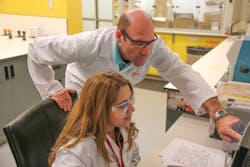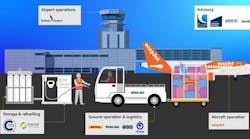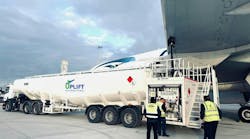Motorsports involves extreme competitiveness, where every fraction of a second is important, and missteps along the way can change a competition's outcome. Tim Shea, aviation gasoline development manager for Shell, says that for him the research and development of new fuels is very similar.
“I like to do things that no one else has ever done before,” he says. “That’s why I helped develop unleaded fuels for motorsports. That’s why I like working on developing an alternative fuel for aviation gasoline (Avgas). Nobody’s done it before, so it’s a good place to be.”
In this game of both knowledge and skill, Shell emerged as a front runner in December 2013. With Shea at the helm of its aviation fuel research and development efforts, the global supplier of aviation fuels and lubricants became the first major oil company to develop a lead-free replacement for Avgas, which is now being evaluated in strict regulatory approvals process.
Airport Business chatted with Shea recently to learn more about the new fuel, the testing results they’ve seen, and where the alternative fuel stands in the regulatory approvals process.
What is the history of Shell’s work on an alternative for 100 Low Lead (100 LL) aviation fuel?
Our work goes back a long way. It began as a motorsports project in 2004 when we were looking for an unleaded fuel that could replace the leaded fuels in the U.S., Canadian and Australian motorsport markets, where leaded race fuels were still commonly used.
In 2008, we completed that work and launched those fuels. It was then that we noticed how the Avgas sector was also under a lot of pressure from the EPA to remove lead. We decided to transfer the technology we used in motorsports fuel to an Avgas product. That work began in earnest in 2010-2011.
If you already had the technology for the motorsports industry, what were some of the differences or challenges you faced in converting it for use in the aviation market?
There are two primary areas that make that challenging. The first one has to do with storage stability. Aviation gasoline tends to be stored for long stretches of time. Because of that, you have to be very specific about the types of molecules you put into the fuel to ensure that they don’t evaporate too quickly. Motorsports has the opposite problem.
The other part has to do with the specifications of the fuel. In motorsports, there really is no specification, it’s open. You design a fuel that works the best, and that’s about it. In aviation gasoline, there is a specification for the current leaded product—ASTM D910. This specification shows all of the current grades of Avgas and provides the physical properties they need to meet to be sold as that grade. We wanted our fuel to, if not match the grade for 100 LL exactly, be as close as possible to it. That is where the challenges came out because aviation gasoline has to be able to withstand very cold temperatures. We had to modify the fuel to give it the low temperatures properties of Avgas.
What kinds of results are you seeing with the alternative fuel Shell has developed?
Our fuel is within the ASTM test specs range, which is quite a wide specification. There are still variants in the fuel being tested. The idea behind our initial flight tests was to demonstrate that the fuel was compatible enough to pass the initial checklist in terms of compatibility with the aircraft and the engine.
This testing centered on whether there were any noticeable differences between our fuel and 100 LL. The data we’ve gotten back so far shows that the differences are indistinguishable. The pilot—who controls the fuel flow to the engine, experiences the condition of his aircraft, and typically fuels it—can’t tell there’s a different fuel in the aircraft. The alternative fuel should be a drop-in type of fuel so that when you use it, you don’t know that you’re using a different fuel.
What is the true definition of a drop-in fuel and what benefits might it bring aviation?
Our take on the definition of a drop-in replacement fuel is that everything from once the fuel is blended and ready to ship, to how you transport it, store it, fuel the aircraft, and how it performs in the aircraft should all be indistinguishable from 100 LL today.
But it really depends on what your frame of reference is. If you’re the pilot, you want to know if you put this fuel in your aircraft will you notice anything different? Does it run the same way? Do you fly the aircraft the same way you used to with 100 LL? A drop-in replacement should be completely transparent to the pilot.
But an OEM will have a different definition for a drop-in fuel. OEMs want to make sure the alternative fuel is compatible with all the materials it comes into contact with for the long term. Aircraft can be out there in the marketplace for decades so long-term compatibility is key. Most people take it as a given that you’re going to meet the engine performance part in terms of how the fuel combusts in an engine. But the biggest questions are more long term. How does the fuel handle itself when it’s exposed to fuel handling equipment, storage systems, and distribution over decades?
What safety issues did you have to meet in developing this fuel?
This has to do with the initial tests with the OEM. The engines are usually pretty straightforward because, for the most part, they’re metal, so they’re not that sensitive to fuel chemistry over short durations. For airframes, it’s obviously a different story because they’re going to be flying.
The typical path you would take is to test the fuel against all of the fuel wetted components. Anything that’s in that aircraft that would come in contact with the fuel needs to be tested for compatibility. Depending on the OEM, sometimes we do that testing here and sometimes the OEM does that testing at their location, and we just ship the fuel to them.
That’s where the safety checklist comes in before we can fly. There are two parts to this: One, we essentially need a note from the engine manufacturer that the fuel is suitable for that engine, so it’s not going to detonate. Then we need the materials compatibility data.
If they do their own testing, they’re going to convince themselves. If we have to do it, we need to put together a report then have a series of calls with them where we walk them through the data, answer their questions, and perform follow-up experiments to demonstrate compatibility that is sufficient for their airframe. It’s quite a process, and it can take upward of a month or so to iron out all the questions.
Where is Shell’s replacement fuel in the regulatory approval process?
There are two parts to the regulatory approval process. The FAA ultimately does the certifying. The FAA involves the American Society for Testing and Materials. The ASTM has a subcommittee that looks after fuels and lubricants, and within that subcommittee, there’s another subcommittee that looks at aviation and where these specifications fall.
If you think about the current product, the ASTM D910 specification, that’s an ASTM specification. What the FAA does is say, “All right. That specifies the fuel.” That tells you the composition the fuel might have, its physical properties and such, and really defines what the fuel is. Then the FAA takes that specification and certifies it. That’s how it works, they’re hand in hand. We’re obviously pursuing both in parallel.
We are working through ASTM, and there are two steps there. There’s a test specification, which is a preliminary step. It just gives some definition of the space that our fuel chemistry looks at but it’s still very broad because as testing goes on we may need to modify or make some changes here and there. It gives us that flexibility. Then once we complete that testing, we go into what’s called a production specification. That’s the final piece. We’re generating the data now to go after that production specification.
In parallel to that, the FAA has their own program that started on July 1, where a number of companies submitted proposals to enter that program and then at the end of August a smaller set of companies was invited into a phase of that program. This program is designed for certification of the fuels.
In the FAA’s, at least a very near-term view, it appears that this is the primary vehicle to achieve certification, which is why we’re participating in that. There are two phases here as well. One revolves around materials compatibility, physical property testing, and so on. The second phase involves engine and airframe testing. The idea behind that is to generate the data sets required to support certification.
How far out do you think we are from having an alternative to 100 LL?
That is the real crystal ball reading. The FAA program, which is designed to go after fleet-wide certification, is expected to run until December of 2018. You are unlikely to have a fleet-wide solution until sometime after that date. We are attempting to work with the FAA at every corner to see if there’s any mechanism to move that forward faster. But there is a lot of work to be done because it’s a very large undertaking. You’re looking at effectively certifying a fuel for every engine and aircraft in the United States.
There is another mechanism to certify fuel, which involves using supplemental-type certificates. However, it’s believed that this is not really the primary vehicle for certification. But it’s important to note that there is another process out there and people are free to attempt to certify in that way. If that happens, you’re more likely to see very limited certifications in the works. You might see people going for certificates for a specific engine and airframe but you’re not going to get the fleet-wide certification you need to commercialize.
What are the benefits in developing a sustainable alternative to 100 LL?
The main one is the removal of lead. If you think about transportation fuels, Avgas is the last fuel that uses lead. Everything has lost it over the years. The primary reason for that is it’s obviously well-known as a neurotoxin, and it bioaccumulates, which means it gets out into the environment and stays there. If it was biodegradable, you probably wouldn’t see near the level of attention it’s receiving now.
How do you make sure the fuel is reproducible in required volumes at a price the aviation industry can afford?
Another key element in the ability to bring an unleaded fuel to market is to make sure that the fuel is actually producible in the volumes required. Different people are looking at very different ways of manufacturing, and with some very new components that are not all from refineries. It’s not just a question of, “Do you have the right materials and can you get enough of the materials?” It’s also, “Are all the materials in the right places?” If there’s a chemical or something you need, and it’s only made in China, that could be a problem if you’re making a fuel for Europe or the United States. It’s a very complex undertaking that often gets lost in the discussion. It is not just about making a fuel chemistry that will work. It’s about being able to actually produce it and supply the market with that fuel. This fuel also needs to be affordable.
This is one of the key parts to our program. We didn’t just look at making a fuel that will satisfy an engine in an airframe and look like 100 LL? It was about, “How can we do this and actually supply the market place?” That meant the materials used for that fuel had to be widely available. We don’t want to get into the business of having to build plants to make something new. We weighed everything out--performance, storage and distribution and manufacturing--all of it. We are confident we have the right chemistry, as well as the infrastructure, to make unleaded Avgas a reality for use in light aircraft engines of all types.




